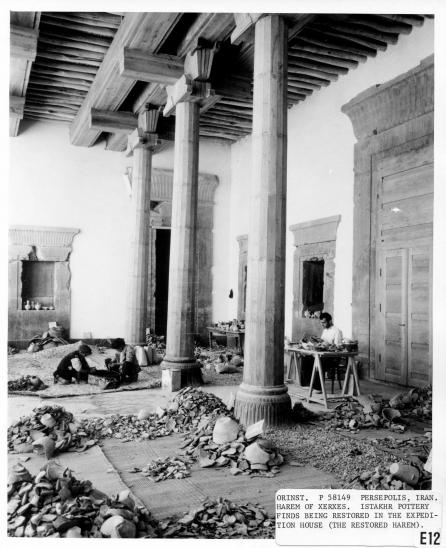I recently wrote a fictional western tale that had to include a theme word: Persepolis. When I was doing a quick word study of Persepolis I became enthralled with the history of the palace and the people connected to it, in part, because it seemed to line up with the book Esther from the Bible.
Much of the history of the time was lost when Alexander the Great made his conquest of the Achaemenid (or Persian) Empire, but some things remained, such as inscriptions carved into the walls of Persepolis and thousands of tablets written in Elamite found on walls and in the Treasury (International Standard Bible Encyclopedia, Bromily G.E.).
Persepolis (Old Persian: Pārśa,[2]New Persian: تخت جمشيدTakht-e Jamshid or پارسهPārseh), literally meaning “city of Persians”,[3] was the ceremonial capital of the Achaemenid Empire(ca. 550–330 BCE).
Courtesy- Wikipedia
Ah, Persepolis! The vast and majestic city with its terraced palace built into the side of Kuh-e Rahmet (the “Mountain of Mercy”). King Darius I, son-in-law of Cyrus the Great, commissioned the building of the stronghold, and it was continued by his son, Xerxes, and his sons after.
Darius’s main seat of rule was at Susa, which was centrally located in the Persian Empire (this particular portion is in modern-day Iran). But when his palace at Persepolis was completed, the city began to be used for various celebrations.
A brief history study of Persepolis indicates that it was difficult to travel there during the cold, rainy season so the palace complex was only used during the dry, warm months of the year. Even after it was a livable estate the kings of Persia continued to divide their time between Susa and Persa (Persepolis). In fact, my further studies indicate there was a well-maintained and traveled road between the two cities.

The name Xerxes stood out to me when I started researching this ancient city. I remembered it from reading Esther umpteen times. The name used in the ES version of the Bible is Ahasuerus, but most commentaries indicate this as the Hebrew version of Xerxes.
Because so much of the history of Persepolis and Susa was lost in the sacking of the cities by Alexander the Great, who destroyed much of what came in his path in regard to anything his enemy might hold sacred, there are not complete records available of the time. Much of what we know about the period comes from Herodotus, the Greek historian, Biblical accounts, and a few other sources.
I became enthralled with the idea that Esther was likely queen during the time of Persepolis’s grand history. The Biblical account takes place at Susa, but it’s not a far stretch of possibility that as a wife of Xerxes she traveled with him to Persepolis.


There is debate surrounding the history of Xerxes, but there’s very little doubt he had many wives, but only one was considered queen. Records seem to indicate his queen’s name was Amestris, supposedly the daughter of a nobleman or general who fought alongside Darius I. There’s not much to go on about her, though.
On a side note, I want to point out that it’s not uncommon for histories written from different cultural backgrounds and at different times to have varying names for the same person. Often it’s a matter of the author’s nationality and the audience for whom they write which dictate the version of a name used in the history.
Xerxes was not Darius’s firstborn son, but Xerxes was the firstborn of his wife, Atossa, who was a daughter of Cyrus the Great. Xerxes was thought to be in his mid-thirties when he became king upon his father Cyrus’s death.
There’s debate about the name Vashti in the account of Esther and how it could be that Vashti and Amestris are one and the same. Vashti is thought to mean “beautiful” or “best.” This could imply she was a favored wife, and it was a term used to describe her, not necessarily her name.
Another hypothesis is that Amestris was actually Esther. I find both options fascinating, but most scholars who have researched the correlation tend to side on that of Vashti and Amestris being the same woman, mostly based on the likelihood that she was his wife before he came to power as king.
Regardless of the sketchy history records, I still found myself intrigued by the two histories meshing together.
Xerxes was in his third year of reign when he repealed Vashti’s queenhood, vowing never to have her come before him again. It seems it took him around three years to move on from her betrayal and find a new queen. During that next year beautiful young women were collected from across the land and brought to the palace at Susa to be prepared to meet the king. In his seventh year of reign he chose Esther to become the new queen. (Book of Esther, Bible)
I am intrigued by the cuneiform text referring to a court official of Xerxes’s by the name of Marduka which correlates with the time line of Esther and her cousin Mordecai (also referenced in International Standard Bible Encyclopedia, Bromily G.E.).
There’s so much more to this historical search, but I can’t possibly discuss it all here, so I’ll leave you with the links scattered throughout if you want to read more on the subject. It’s fascinating and reminds me why I love history so much.
Persepolis opened up a whole page of history about which I didn’t even know I wanted to discover more. Now, if only I could go visit the ruins, touch the limestone, and imagine the grand estate in its glory days.

Please leave a comment, question, or idea! I’d love to chat!